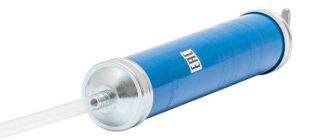Car servicing involves diagnosing all its components, as well as periodically changing consumable parts and technical fluids. Most often, car enthusiasts have to change their engine oil; transmission fluid does not need to be replaced so often.
Despite the fact that both compositions belong to the category of lubricating oils, their properties differ. These two lubricant materials should not be confused.
What is motor oil and why does a car need it?
Motor oil is designed to lubricate the mechanisms in a car engine. Each individual car model requires its own motor oil with certain characteristics. Oil is classified by letters and numbers. Based on these parameters, you can clearly find out the characteristics. Motor oil usually consists of base oil obtained after oil refining and additives. Motor oil can be mineral, synthetic or semi-synthetic. In order for the car to work correctly and its service life to increase greatly, it is necessary to choose those oils that are recommended by the vehicle manufacturer.
How to choose transmission and engine oil
First of all, it is worth understanding that each of the oils has its own nuances. So for gear oil, you need to pay attention to the following factors.
- When choosing, you should look at the degree of wear of the gearbox. So, each season has its own type of gear oil. But it is best to take semi-synthetic, as it is suitable for all seasons.
- It would be best to look at the viscosity of the oil , since the safety of the components will depend on this.
- It would be advisable to buy the oil that recommended by the manufacturer himself.
Classification of transmission oils
As for engine oil , the recommendations are almost the same as for transmission oil. Of course, you should listen to the seller’s advice, but at the same time you must remember that it is best to buy what the manufacturer himself advised.
Transmission and engine oils are both essential to the long life of your vehicle. You must remember that under no circumstances should they be mixed, and when changing oils, you need to thoroughly flush the inside of the car to avoid further damage.
What is gear oil?
Gear oil has increased resistance to high loads. In addition, this oil has a high viscosity, due to which it perfectly suppresses noise emitted by working mechanisms, removes heat that appears during friction and eliminates the possibility of rapid wear of components. Transmission oils should never be mixed due to the high risk of breakdowns. To change the transmission oil, it is necessary to completely drain and clean the system of old lubricant. When choosing gear oil, preference should be given to those oils recommended by the manufacturer.
Is it possible to distinguish between oils?
To visually distinguish transmission oil from motor oil, simply dip two fingers into the oil and then slowly spread them apart. The film of motor oil stretches up to 3 mm, while in transmission oil it breaks literally immediately. In addition, you can distinguish the compositions by smell. Transmission compounds may smell like garlic or sulfur. This cannot happen with motor oils.
You can learn more about the difference between engine oil and transmission oil in this video:
Information on how to distinguish motor oil from transmission oil may be of interest to both drivers and people who are just planning to buy a car. It seems much simpler: you chose a canister with the appropriate label in the store, poured oil into the designated place, put the canister with the remaining substance on a shelf in the garage - and no worries!
Motor and transmission oils differ in characteristics.
Are there any differences between them
Requirements for the composition of lubricating fluids for different cars may differ; specific tolerances and recommendations can be found in the service book. But it’s already clear from the names that transmission and engine oil are not the same thing. They seem to serve a similar role: protecting parts from wear, friction and corrosion. But in fact, these liquids have serious differences in composition, properties and principles of action. Even “universal” emulsions, according to emulsion manufacturers, are actually just suitable for different models of gearboxes or engines. Therefore, the same lubricant cannot be used for all parts of the car. In order to better understand how to distinguish between gear oil and motor oil, you need to know the signs and characteristics of both fluids.
What can cause an error when filling oil?
Filling with transmission oil will damage the engine.
To an inexperienced person, all fuels and lubricants look the same, but the ingredients of oils differ significantly from each other. Even a small volume (100-200 ml) of transmission oil poured into the engine can lead to mechanism failure. The “blame” for this is the additives to the substance, which are designed to help fulfill clearly defined tasks: to ensure the operation of mechanisms in conditions of high or low temperatures, preventing their wear.
Transmission oil is not designed to operate at elevated temperatures. Once in an environment where the temperature exceeds 150 o C, the substance begins to burn out. Scale and flakes of burnt substances form and settle on engine parts. If the owner of the car comes to his senses in time and drains the substance, the engine can be saved. Otherwise, a major engine overhaul is at risk.
The same sad consequences await the engine if oils are accidentally mixed. As you know, when adding oil to the engine, it is not allowed to mix different types of lubricant: for example, synthetic and semi-synthetic, synthetic and mineral, etc. As a result of such manipulations, the performance characteristics of the substances drop sharply, the quality deteriorates, which ultimately causes breakdown of the engine mechanisms .
Motor oil has a higher viscosity.
Even the most experienced mechanic cannot predict the consequences of mixing substances for the gearbox and engine. Today there are a large number of brands of both motor and transmission oils. Each manufacturer uses original ingredients, which, when shaken or heated, can lead to unexpected chemical reactions.
The simplest thing that can be assumed is the foaming of the substance, the formation of a heavy sediment or clots, and the substance acquiring a paste-like state.
If you add a little motor lubricant to the gearbox, you will notice not only changes in the appearance and consistency of the substance, but also a deterioration in the operation of the transmission. This will be facilitated by higher engine oil viscosity.
Some experienced drivers note that in extreme situations, engine fluid can save the situation: for example, the car is stopped, there is forest all around, you can’t call for help, the only oil you have is the transmission.
The only way out here is to pour the substance into the engine, drive to populated areas and immediately contact a service station. It will be necessary not only to replace the engine lubricant, but also to flush it.
What happens if you mix up the oils?
If you mix up the oils, the car may fail. For example, if transmission fluid is mistakenly poured into the engine, the power unit is very likely to fail altogether.
The bottom line is that such a liquid, entering a new and unfavorable environment for it with a high, harsh temperature regime, will burn out after a short time and turn into sludge, deposited inside the engine walls as scale. If, on the contrary, you pour motor lubricant into the gearbox, the consequences will not be so depressing.
Experts do not recommend experimenting with such things, since it is unacceptable to risk the “health” of a car, as well as a person. Ultimately, his treatment will be expensive, if it will help at all.
How to distinguish between types of oils
Gear oil will create a rainbow-colored film on the water.
Some auto mechanics who have been working with fuels and lubricants for a long time are able to not only distinguish their purpose, but are also able to approximately name the manufacturer. Unfortunately, ordinary car enthusiasts do not have such knowledge. Therefore, it is necessary to remember 3 main methods that you can rely on if you need to determine the type of oil:
- By smell. Since transmission oil contains a large number of chemical additives, which may include fluorine, sulfur, phosphorus, molybdenum disulfide, etc., the substance has a very specific odor. Some substances smell like sulfur, others like garlic. But you should not rely on just one method of determination, since the smell could have evaporated from a loosely closed canister or the person does not have a sufficient sense of smell.
- By appearance. You need to put 2 fingers together and dip them into an unidentified substance. Then the fingers slowly spread apart. If the oil is motor oil, the film will begin to stretch behind your finger by 2-3 mm, if it is transmission oil, it will immediately break. The method should also not be considered very reliable, since sometimes only a very experienced and attentive person can notice the moment the film breaks.
- Using water is the most commonly used method and does not require special care. Pour a little clean water into a wide container (cup, bowl), and then drop in the substance to be determined. A drop that immediately spreads across the surface of the water like a rainbow film will indicate gearbox fluid. If the drop has acquired the shape of a lens and floats on the surface for some time without changing, it is motor oil.
Oil recognition
They say that experienced auto mechanics can distinguish not only between a motor and a transmission by external signs, but also approximately name their brand. However, ordinary car enthusiasts do not have such knowledge. There are several signs you can look out for.
- Olfactory
. Transmission oil has a very specific smell. To some it smells like garlic, to others it smells like sulfur. However, you should not rely only on aroma. And the absence of a stink does not guarantee that this is motor oil: your runny nose or a poorly screwed cap on the bottle, which has released a significant part of the fumes, can be misleading; - Tactile
. Squeeze 2 fingers, dip into an unidentified oil and slowly spread. The film from the engine oil will stretch by 2-3 mm, and from the transmission oil it will break immediately. The method is also not very reliable: if you have not tried to do this before, it is quite difficult to truncate the moment of rupture and the distance; - Vodyanoy
. Considered to be the most vocal. A little water is poured into any container, and suspicious oil is dripped into it. If the drop immediately spreads across the water like a rainbow film, you are dealing with the transmission. If the lens dissolves reluctantly and floats for several minutes, almost without losing its shape, you have motor oil in the bottle.
Read also: Mercedes glc coupe video test drive
An even less reliable sign is peeling and blurring of labels. It is believed that this is the effect of exclusively transmission oil. Although, logically speaking, pieces of paper can come off due to humidity, and letters can become blurred due to the ingress of other liquids. So, if the bottle is practically empty, and you are not very pressed for money, it is better not to guess how to distinguish engine oil from transmission oil, not to experiment, but to buy new one. Repairs, flushing and complete replacement will in any case cost more.
How to distinguish engine oil from transmission oil? A few simple details
It is clear that there are certain nuances and characteristic features for each species. And in general, what are the dangers of such an operation if a misunderstanding does occur? In this case, professionals recommend draining the oil completely, cleaning the engine with a special flush and refilling with fresh oil specifically intended for the engine. And do it as quickly as possible!
How to distinguish engine oil from transmission oil?
There are several folk methods and signs that can always be used to determine the difference if the label is torn off. But let’s first figure out why flooding with the wrong composition is dangerous for a car. And what actions should be taken if there is confusion.
In theory, the base of both types of oil is the same. They differ in additives designed to adapt the base to perform clearly defined tasks. And these additives are almost always not friendly with each other.
Possible consequences:
Gear oil is not intended for use at high temperatures. In the engine they go off scale. Accordingly, the transmission poured into it will burn out at an unimaginable speed, forming stuck layers on everything it touches.
If the operation does not last long, then a disaster most likely will not happen. But if you give up, you can get to the capital. Experienced car owners know that even motor oils of different compositions cannot be mixed (for example, mineral water and synthetics are certainly not recommended). And here are liquids for different purposes.
The consequences of their interaction are impossible to predict. The simplest option is foaming the oil. However, the formation of clots or sediments, or even thickening of the oil to a paste-like state, is no less likely. How lucky you personally will be is a matter of individual luck.
If the situation is the opposite (), then in addition to the possible reaction of additives with each other, difficult operation of the transmission will be observed. Motor oil is more viscous, although this cannot be determined visually.
At the same time, experienced drivers admit that in the most extreme cases it is still possible to fill the engine with a transmission. However, only until you reach your base. And in order to avoid various complications, the oil must be changed completely after this, and even with additional flushing of the engine.
They say that experienced auto mechanics can distinguish not only between a motor and a transmission by external signs, but also approximately name their brand. However, ordinary car enthusiasts do not have such knowledge. There are several signs you can look out for.
- Olfactory
. Transmission oil has a very specific smell. To some it smells like garlic, to others it smells like sulfur. However, you should not rely only on aroma. And the absence of a stink does not guarantee that this is motor oil: your runny nose or a poorly screwed cap on the bottle, which has released a significant part of the fumes, can be misleading;
- Tactile
. Squeeze 2 fingers, dip into an unidentified oil and slowly spread. The film from the engine oil will stretch by 2-3 mm, and from the transmission oil it will break immediately. The method is also not very reliable: if you have not tried to do this before, it is quite difficult to truncate the moment of rupture and the distance;
- Vodyanoy
. Considered to be the most vocal. A little water is poured into any container, and suspicious oil is dripped into it. If the drop immediately spreads across the water like a rainbow film, you are dealing with the transmission. If the lens dissolves reluctantly and floats for several minutes, almost without losing its shape, you have motor oil in the bottle.
Read also: Characteristics of the fuel pump VAZ 2110
Knowledge of automotive intricacies greatly helps in practice not only for those drivers who have little experience in operating a car, but also for experienced professionals. Among these important subtleties, undoubtedly, is the knowledge of what signs and how to distinguish transmission oil from motor oil.
Visual ways to distinguish engine oil from transmission oil
At first glance, the ability to distinguish motor oil from transmission oil is not important. After all, it’s easy to choose the right material in the store: there are corresponding instructions on the canisters, and the sellers will tell you. All that remains is to choose a brand and fill it into the car for its intended purpose. However, there is always an unused residue that sits in the container until you have to add oil. It is not always possible to determine the purpose of the liquid from old packaging. The driver is faced with a choice: either pour out the oil or find out its type.
Engine oil
Motor oil is usually used for the car brand according to the manufacturer's recommendation.
Engine oils have their own classification, which is accepted all over the world and indicates the viscosity of the lubricant, which determines its main characteristics. Typically, an oil contains one specific base and a number of additives.
The main difference between different types of engine oils is their origin: mineral, semi-synthetic or synthetic.
Engine oil operates under fairly high loads and temperatures, so it must match the engine model in order to ensure maximum operational reliability and service life.
Why is it important to know the purpose of the oil?
Visually, all oils look almost the same. But liquids for different purposes have different compositions. First of all, they differ in the set of additives, which is determined based on the operating conditions of the oil. Therefore, even a small amount of transmission oil that gets into the engine can significantly disrupt its operation.
Transmission oil has a composition designed for operation at low temperatures. Therefore, when it gets into the engine and gets very hot during operation, the oil burns out. This leads to the accumulation of combustion products in the engine. If transmission oil is used instead of engine oil for only a short time, after which it is drained and the engine is washed, negative consequences can be avoided. But if measures are not taken in time, everything will probably end in engine overhaul.
A serious mistake would be not only pouring transmission oil into the engine, but also mixing different types of oils. Mixing liquids with different bases (for example, synthetics and mineral water) is not allowed. Even if good oils are mixed, the result will be a material that is unusable.
Distinctive features
The key difference between these lubricants is their composition and technical characteristics. Manufacturers make each type as effective as possible under their own conditions, so specific impurities and additives are added there. What works well in one system may harm another.
Engine oil
As the name suggests, the main purpose of this type of lubricant is to protect the engine from excessive friction and damage. All parts and components of the engine are constantly in contact with each other, and the oil prevents them from being damaged. Modern oils are divided by composition into mineral, synthetic and semi-synthetic. At the same time, additional additives are placed on the base basis of any of them. They can provide protection against overheating, corrosion, or form a thin film to fill microcracks on the engine surface. In addition, oils differ in class: summer, winter and all-season. This determines their viscosity index, pour point and density. Depending on these parameters, each lubricant is suitable for certain engine models.
Transmission fluid
The main task of this oil is to create a dense and durable film on the transmission system. This part is constantly used during vehicle operation and therefore experiences heavy loads.
Excessive friction can lead to transmission problems and jerking when shifting gears. Therefore, gear oils have a viscous and dense structure, as well as a lower degree of liquefaction. In addition, special additives are added to them, which provide additional strength and wear resistance. The resulting oil film has a more viscous structure. But due to impurities, gear oil has a low viscosity index and does not tolerate temperature changes well. It is too thick for this, so it is only good for stable operation in one mode.
How to determine the type of oil?
Experienced craftsmen, through whose hands dozens of brands of various oils have passed, claim that they can visually determine not only the purpose of the oil, but also its manufacturer. The average car enthusiast cannot do this. But there are 3 criteria that allow you to distinguish engine oil from transmission oil:
- Smell. Transmission oil has a characteristic odor due to the presence of a number of chemical elements in it (sulfur, phosphorus, fluorine, etc.). They are part of the additives used in lubricants. The reliability of this criterion is low, since over time the smell is lost, and not everyone can boast of a keen sense of smell.
- Appearance. It is necessary to check the viscosity of the oil by assessing the strength of the oil film. 2 fingers, folded together, are dipped into the liquid, removed from it and carefully spread to the sides. If the oil is motor oil, the film will stretch by 2 - 3 mm. If it’s a transmission, it will break instantly. This criterion also has a drawback: it is difficult to detect the moment the film breaks.
- Behavior on the water. The criterion is the most objective. The test consists of assessing the behavior of an oil drop in water. If you drop the transmission into water, it will immediately spread into a thin layer. If motor oil is used, the drop will retain its round shape and float on the surface.
The subjectivity of each criterion is quite high, so experts do not advise relying too much on them.
In order not to miss anything, you can subscribe to the newsletter by simply clicking on the button below!
Transmission fluid differences
The main task of the transmission fluid is to create a more durable oil film on the parts of this design. This requirement determines the key difference between gear oil. It is explained by the fact that the parts of the transmission rub with much greater force and receive a much greater mechanical load than in the engine, and if they are not lubricated abundantly, they wear out very quickly and fail. The composition of such a liquid is created taking into account the fact that it will have to work at a more gentle temperature regime than engine oil. Moreover, this mode is, as a rule, stable in nature, without sudden changes, as is recorded in a car engine.
Because of this, such liquids are also quite viscous, but in terms of viscosity they are still inferior to motor oil. The main functional difference is achieved due to an additive different from that in motor oil, designed to provide reliable protection against enormous mechanical loads.
Read also: How not to stall on a hill











